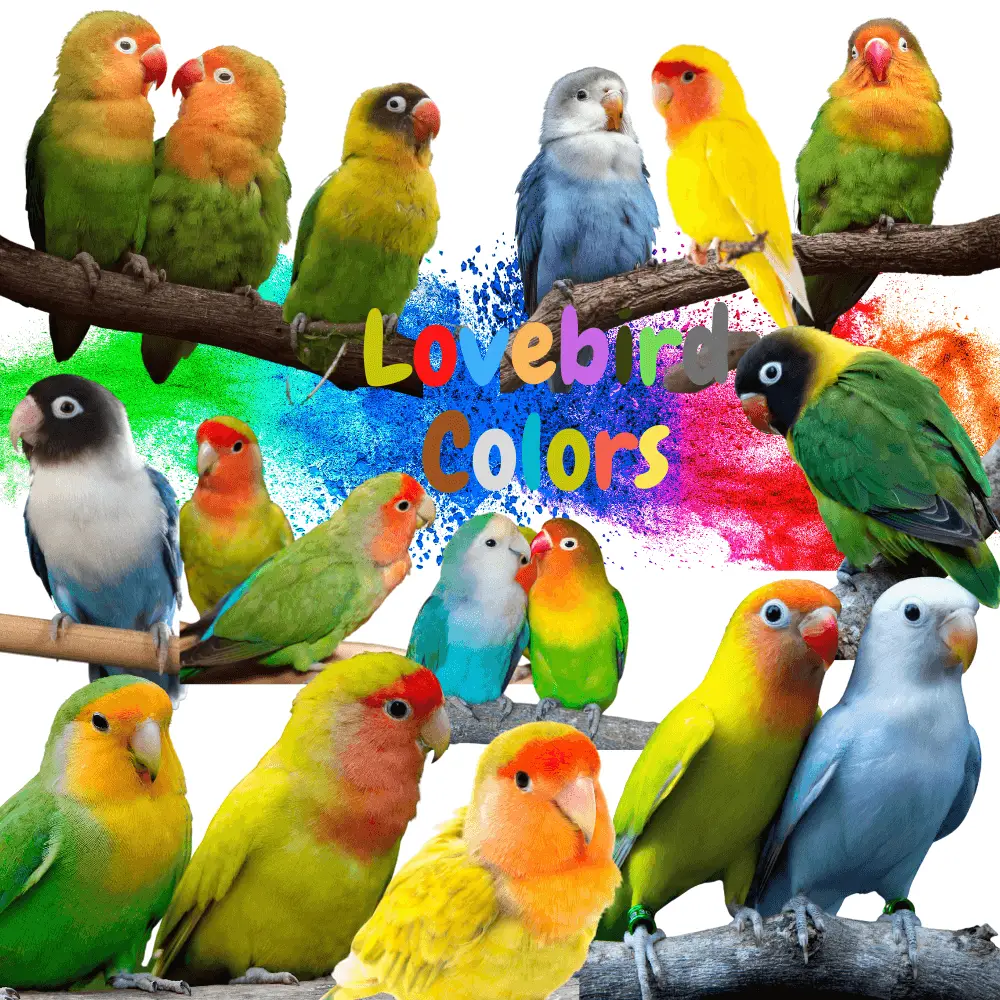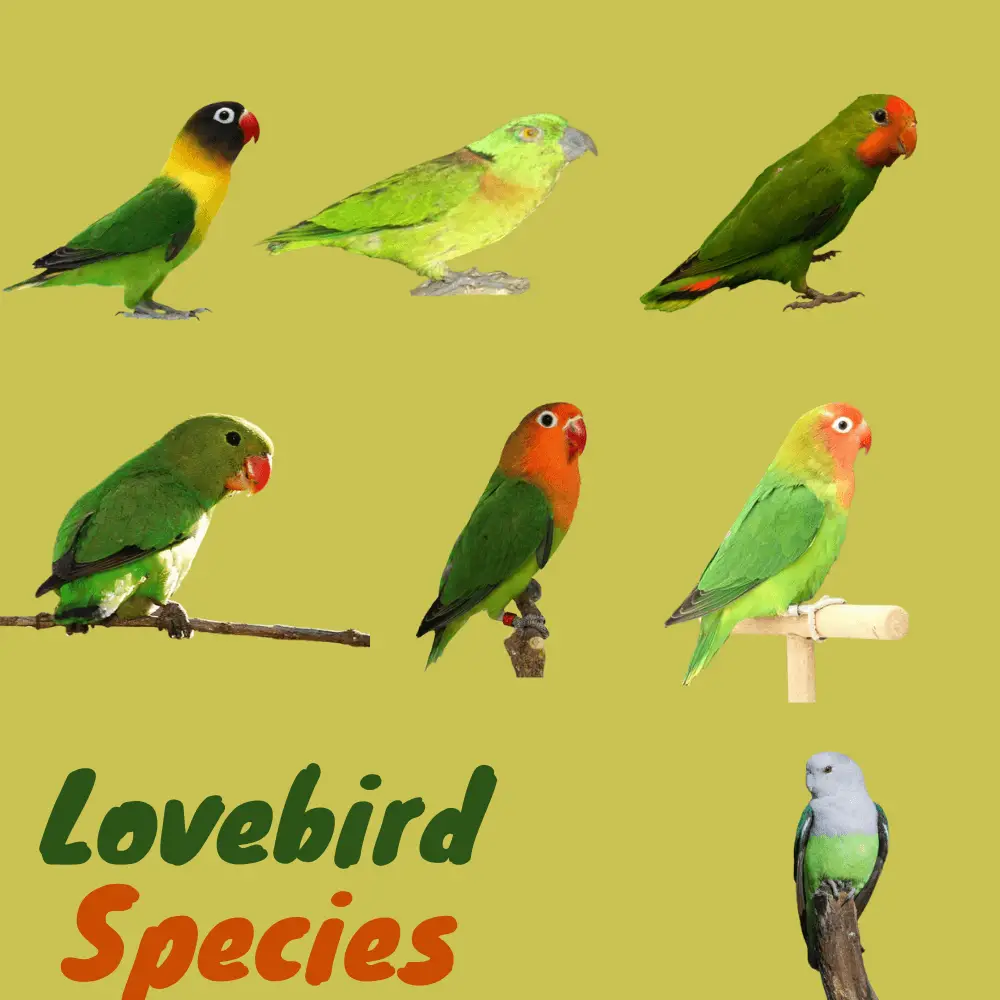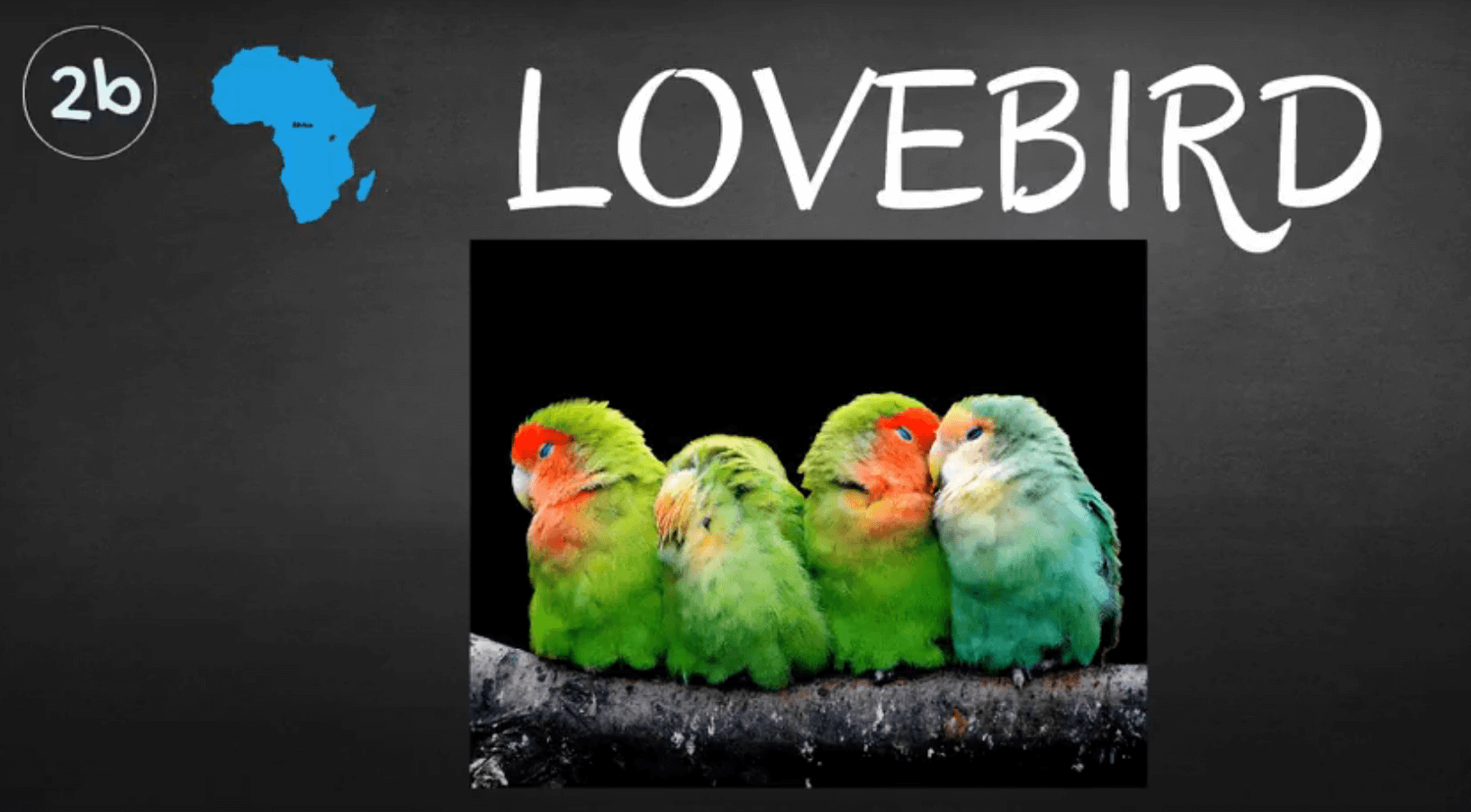
Lovebird colors: Lovebirds are small birds that are part of the Psittacidae family. These small parrots live wild in southern Africa. Their brightly colored plumage, amusing behavior, and intelligence are making them increasingly popular birds. They are affectionate and relatively easy to train and tame.
Lovebirds are small, colorful parrots from North Africa. The technical name Agapornis means “Birds who love each other”, in fact, it is precisely their particularity: they bind to a companion of life and show great fidelity! Let’s discover the different species together.
Lovebirds’ plumage is of a combination of many colors on their face and body feather, green color, yellow color, peach color, orange color, violet color, teal color, white color, black color, or grey color. The lovebird’s beaks vary in color!
The different types of lovebirds can be distinguished by colored feathers and particular signs dictated by unique color combinations. Of the nine species of parrot lovebirds, three, in particular, are the most common or rather domesticated: the face lovebird, the Fischer’s lovebird, and the masked lovebird.
Lovebird colors

Biological Species Lovebirds
- Rosy-faced lovebird: The rosy-faced lovebird, also known as the rosy-collared or peach-faced lovebird,
- Lilian’s lovebird: Lilian’s lovebird, also known as the Nyasa lovebird
- Black-winged lovebird: The black-winged lovebird also known as Abyssinian lovebird
- Fischer’s lovebird: Fischer’s lovebird is a small parrot species of the genus Agapornis
- Grey-headed lovebird: The gray-headed lovebird or Madagascar lovebird
- Red-headed lovebird: The red-headed lovebird also known as the red-faced lovebird
- Yellow-collared lovebird: The yellow-collared lovebird, or masked lovebird, black-masked lovebird or eye ring lovebird
- Black-cheeked lovebird :The black-cheeked lovebird is a small parrot species of the lovebird genu
- Black-collared lovebird: The black-collared lovebird also known as Swindern’s lovebird
The lovebird RoseGorge
The Peach-faced Lovebird (Agapornis roseicollis) has mainly green plumage with a bright blue part on the back. It has a peachy pink area – hence its name – that runs from the forehead to the upper neck, passing behind the eyes, cheeks, and throat. The beak is horn-colored with a shade of light green, and the legs are gray.
They are lively and not very noisy, except in the mornings when they wake up particularly active and euphoric and begin to whistle attracting the attention of their owner… In these cases, be sure to provide them with toys with which they can spend some time!
The Lovebird Fischer
The ‘Fischer’ Lovebird (Agapornis fischeri) has a green lower body that gradually fades to deep yellow. The forehead, cheeks, and throat are orange-red and the rest of the head is dull olive green, while the beak is bright red.
Fischers are affectionate, and talkative, and sing and whistle all day. They need a lot of attention, so if they don’t live with their own species, they need to interact with you, exercising and playing outside of the cage. For this reason, there are models of cages with an opening roof, such as the Greta Ferplast model, equipped with a perch on the top to allow them to observe us more closely and interact with you.
The peculiarity of this species is that, unlike the others, it is not able to handle food with one paw, so do not forget to cut it into small pieces before giving it.
The Masked Lovebird
The Masked Lovebird (Agapornis personata) is a green-feathered parrot. The head is brown-black in Lovebird colors with a yellow collar, even the chest, and throat are yellow, with a red-orange spot. The back feathers, on the other hand, are bluish and the beak red.
The Masked Lovebird has a nice and sociable character, but if you ignore them, he may get bored and lose control a bit! It is not a songbird, but it chirps and whistles, which is why it can live in an apartment.
Please note that if you wish to adopt a couple of lovebirds, it is mandatory to hold documents that certify the origin of the birds and attest to the regular sale.
Behavior & character
Naturally gregarious, the lovebird is very sociable provided you interact a lot with it during its growth. As with other parrots, more than one person should raise and train the baby birds to prevent them from becoming possessive and bonding with just one person.
Tendency to bite: bites are often frequent in the female lovebird. This behavior can be avoided by learning to spot the signs she shows you.
Ability to speak: the lovebird is a parrot bird that lacks the ability to speak. He can sometimes say very simple words like “hello” and “hello”. It can also reproduce the sound of certain objects such as microwave or timer sounds.
Lovebird colors

Appearance & Features
It is a small parrot with an elongated shape, very agile, with a short tail, whose main characteristic is its pink face. In the natural state, the plumage of the Lovebird is green with shades of different Lovebird colors, darker on the wings and lighter in the pectoral area and in the undertail region. There are many mutations, the best known of which is the lutino, with a pink face and very bright yellow plumage, the legs are gray, and the beak is meaty in adults and brown in young subjects.
- Wingspan: 25cm.
- ORIGIN Africa and adjacent islands
- IUCN STATUS NT
- Scientific name: Agapornis roseicollis
- Order: Psittaciformes
- Family: Psittaculidae
- Genre: Agapornis
- MALE SIZE 12-18 cm
- FEMALE SIZE 12-15 cm
- MALE WEIGHT 40-60 gr
- FEMALE WEIGHT 40-60 gr
Lovebird colors

Living conditions
Ideally, the largest possible cage is always best when choosing birds to breed in captivity.
The cage
Choose a cage preferably with feet. If it is not equipped with one, place the cage high up, away from drafts and temperature variations. For a pair of lovebirds, you need at least a cage 50cm high, for a floor area of 60x40cm. Make sure you have a cage with locks because the lovebird is known for its ability to escape.
If you have several exotic birds, equip the cage with several nesting boxes to avoid quarrels between congeners. In cold weather, it is advisable to equip yourself with a heated shelter to house them. Install your lovebird’s cage in a room where there is life and do not isolate it from the rest of the family.
It is necessary to equip the cage of your lovebirds with several accessories:
- Perches.
- Wood chips, and branches of fruit trees so that they can build their nest.
- Perches.
- Waterers and feeders.
- A bunch of millet.
- A cuttlebone.
Remember to cover the bottom of the cage with sand, not sharp pebbles. Renew it regularly. Take the opportunity to clean the bars, the perches, and all the cage accessories. Change the water in the tub and drink troughs daily.
Other species
There are three major groups of Lovebirds. Their size varies according to the species of these groups, but they generally measure between 12 and 18cm. Regardless of its species, the lovebird is a bird that likes to live in contact with others.
The group with sexual dimorphism :
- Agapornis pullarius,
- Agapornis’s age
- Agapornis taranta.
The group with the white eyering :
- disguised as a lovebird
- Agapornis fischeri,
- Agapornis nigrigenis,
- Lily of the valley
The group without sexual dimorphism and without white eye-ring :
- Agapornis roseicollis,
- Agapornis swindernanius.
Sexual dimorphism
In some species of exotic birds, one can easily distinguish a male from a female. This is the case with some lovebirds: in the grey-headed lovebird, the male is the only one to have a head of this color. The female has a green head. This is also the case with the red-headed lovebird: the female also has a green head.
However, there is no external dimorphism in masked lovebirds, Fischer’s lovebirds, rosy-faced lovebirds, and black-cheeked lovebirds.
To tell the sex of these species, ask your veterinarian to perform an endoscopy to reliably determine the sex of your bird. It is possible, for the most seasoned, to determine the sex of a lovebird by observing its behavior in a group.
Feed
The lovebird’s diet should consist of 70-90% compound foods, 5-20% high-quality seeds, 5% fruits and vegetables, and 5-10% rice, pasta, and healthy homemade meals. A diet of only regular seeds can lead to obesity and calcium and vitamin deficiencies.
Seeds, fruits, and vegetables: are grain-eating birds: that feed mainly on seeds. It is still necessary to vary the diet of your exotic birds by offering them fruits such as apples, grapes, bananas, and red fruits or vegetables such as spinach, peppers, and tomatoes…
Citrus fruits in small quantities: give citrus fruits and green apples in small quantities. Since they are more acidic, some lovebirds might have difficulty digesting them. If regurgitation occurs, stop giving it to them. Always wash the fruits and vegetables you offer them. Certain foods such as avocado, beet greens, and raw potatoes should be avoided.
Tap water: in most cases, it is very suitable for lovebirds. Spring water is preferable for the administration of medicines or vitamins because the chlorine contained in tap water can destroy the effect of treatments. The water in the drinkers must be renewed every day, especially in summer, and the drinkers cleaned.
Food supplements
It is necessary to give a vitamin and mineral supplement to the lovebirds. For this, you can offer them:
- Egg pâté: a supplement providing them with amino acids, vitamins, minerals, and trace elements.
- Sprouted seeds: rich in vitamins and highly digestible.
- Green foods provide them with vitamins and minerals such as lettuce, endive, carrots, dandelion…
During molting, these food supplements are essential.
Health
Despite their reputation as beloved companions, it should be noted that various illnesses can affect lovebirds throughout their lives. Some are common in species of this genus, while others can arise from mishandling by owners.
Besides the fact that it is a resistant and robust bird, the lovebird can be affected by stress. Occasionally, he may self-mutilate and develop polyfollicles. Screening for avian polyoma and PBFD (Psittacine Beak and Feather Disease) is necessary.
Avoid subjecting it to temperature changes. Keep it away from danger because it is a bird that likes to explore its environment.
All Lovebirds Color mutation
SOURCE: Birds care & information
Related Articles:
- Agapornis canus – Grey-headed Lovebird
- Agapornis pullarius – Red-headed Lovebird
- Agapornis taranta – Abyssinian Lovebird
- Agapornis swindernianus – Black-collared Lovebird
- Agapornis roseicollis – Peach-faced Lovebird
- Agapornis fischeri – Fischer’s Lovebird
- Agapornis personatus – Masked Lovebird
- Agapornis lilianae – Lilian’s Lovebird
- Agapornis nigrigenis – Black-cheeked Lovebird
- Gray-headed Lovebird
- Red-headed Lovebird
- Yellow-collared Lovebird
- Rosy-faced Lovebird




















